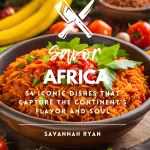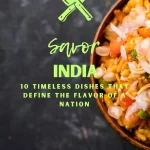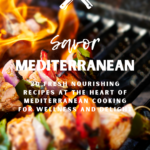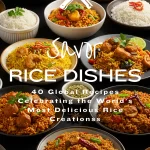Global recipes are more than ingredients. They’re stories of heritage and tradition. Our international cookbook collection showcases dishes like Japan’s sushi, Italy’s pizza, and Mexico’s tacos. Each dish is a window into the culture that created it.
Every recipe in this series shares a story of resilience, creativity, and shared humanity. It’s a journey through the world’s flavors and traditions.
Imagine cooking Syria’s falafel from Imad’s Syrian Kitchen or tasting Peru’s ceviche. You’ll learn how spices like berbere in Ethiopia’s doro wat or saffron in Spain’s paella connect communities. This is more than a culinary journey. It’s a celebration of how food brings us together.

Whether you’re baking France’s coq au vin or mastering Thailand’s pad thai, these iconic dishes are for home cooks. Our guides make techniques from India’s tandoori chicken to Brazil’s feijoada easy. They blend tradition with practical tips for today’s kitchens. Every page takes you on a journey, turning your stove into a passport.
Discover how a single pot of Nigeria’s jollof rice or Korea’s kimchi holds generations of culinary wisdom. These world cuisine classics are more than meals. They’re invitations to savor the world’s soul, one flavorful bite at a time.
Journey Through Global Cuisine: What Makes This Collection Special
Our global cookbook collection is more than just a book. It connects cultures and kitchens. Each authentic recipe comes with a story of its origins.
Imagine learning about Ethiopian injera bread and its role in community meals. Or how Japanese matcha ceremonies honor tradition. These culinary traditions are not just flavors; they’re living histories.
We made sure every dish fits in your kitchen. Our recipe adaptations make complex techniques easy. You can make Moroccan tagine or Thai curry without special ingredients.
Using pantry kitchen essentials is key. No need for exotic markets. Just smart swaps, like coconut milk for lao herbs. Every step was tested in home kitchens for real-life ease.
Discover why global flavors can be simple. This book turns faraway traditions into weekly meals. From spices to stories, we’ve made global kitchens accessible, one pot at a time.
The Essential Global Cookbooks Guide for Culinary Enthusiasts
Building a culinary library with essential cookbooks is key to mastering diverse cuisines. Start with foundational titles like Salt, Fat, Acid, Heat by Samin Nosrat, which breaks down universal principles. Pair it with On Food and Cooking by Harold McGee to understand science behind techniques. These international cooking guides turn curiosity into confidence.
Our cookbook recommendations prioritize practicality. For example, Regional Mexican Cooking by Maricel Presilla teaches authentic methods, while The Flavor Equation by Nik Sharma decodes flavor layering. Even everyday meals improve with these resources—try How to Cook Everything by Mark Bittman, a staple for cooking skill development basics. Savannah Ryan’s journey in this space shows how these books simplify mastering global flavors at home.
A smart culinary library balances technique and culture. Explore Black Food by Bryant Terry for diasporic stories or Meat: A Kitchen Education for protein mastery. Prioritize guides that blend theory with hands-on steps—like La Technique by Jacques Pépin—for foundational skills. Every book chosen should expand your toolkit without overwhelming your shelf. Whether mastering pho broth or perfecting brioche, these picks transform inspiration into kitchen competence.
From Street Food to Family Traditions: The Culinary Spectrum
Global street food and family recipes are closely linked. Our cookbook shows how they both shape our cultural identity. From Bangkok’s markets to family kitchens, these traditions connect us to our heritage.
Street food is all about spontaneity. Think of Mexico’s tamales or Thailand’s pad thai. These dishes come from creativity and community, using local ingredients.
Our guide makes it easy to recreate these dishes at home. For example, making Vietnamese pho broth with common ingredients.
Family recipes hold deep meaning. Think of an Italian nonna’s pasta sauce or a Korean family’s kimchi recipe. These stories teach us history and more than just recipes.
We provide step-by-step tips for mastering traditional cooking methods. This includes slow-cooking and fermentation, without any guesswork.
From Japan’s washoku to Senegal’s ceebu jen, these traditions live in every kitchen. Our book helps you preserve these stories while making them fit into today’s busy lives. Every recipe respects its roots while being easy to make today.
Continental Highlights: A Taste of Every Corner of the World
Our collection of global cuisine brings flavors to life. From Italy’s simple dishes to bold African spices, each dish has a story. We make international cooking easy for your kitchen.
Iconic dishes from around the world are showcased. Think Spain’s paella, Ethiopia’s doro wat, or Lebanon’s kibbeh. Each dish reflects the culture behind it, like India’s tandoori cooking or Thailand’s stir-fries.
We make complex cooking simple. For example, balancing Thai flavors or perfecting Italian pasta sauces. This way, you can enjoy dishes from Eastern Europe and Cuba, even with rare ingredients.
Master Chef Techniques Made Accessible for Home Cooks
We think every home cook should learn chef techniques without feeling scared. Our guide shows you how to make Peking Duck’s skin crispy or balance paella’s rice. It uses simple kitchen equipment.
The Atria Books manual from 2015 has 100 recipes. They mix tradition with new ideas, like Buffalo Chicken with Celeriac Slaw. You’ll also learn basic culinary skills.
Learning home cooking methods means understanding the reasons behind each step. Marinating times and temperature control are based on science. Our cooking tutorials teach you about texture, color, and how to fix problems.
You can use a cast iron skillet with foil-wrapped brick to cook chicken. This shows that you don’t need special tools to be creative.
Check out step-by-step guides at seasoning basics to improve flavor. The manual has 15 chapters, including more on fish and pasta. It helps you get better at many dishes.
Whether it’s sharpening knives or making sauces, these lessons let you try new things. Boost your kitchen skills today. Visit grahamelliot.com to begin your cooking adventure.
Ingredient Spotlight: Essential Pantry Items for Global Cooking
Every kitchen adventure begins with a well-stocked pantry. Building your global pantry essentials is crucial for mastering international flavors. Choose items like soy sauce for Asian dishes, cumin for Mexican, and harissa for North African. Start with a few items and add more as you try new recipes!
Organizing your pantry wisely saves time and reduces waste. Group items by cuisine or function. Store dried herbs and spices in airtight containers away from heat. For specialty food items like sumac or yuzu kosho, keep them in the fridge once opened to keep them fresh.
- Grains & Legumes: Stock quick-cooking quinoa, couscous, and lentils. Whole grains like farro add depth to salads and soups.
- Essential Spices: Turmeric, cumin, and smoked paprika are the base of many dishes. Try blends like dukkah or ras el hanout.
- Condiments: Always have tahini, miso paste, and fish sauce ready. These can turn simple dishes into authentic global bites.
Don’t worry if a recipe calls for something unusual. Use ingredient substitutes like Aleppo pepper for cayenne or labneh for yogurt. Most specialty food items are online or at ethnic grocery stores. Try Kirkland Signature for bulk spices or Trader Joe’s for pantry staples.
Storage hacks: Freeze nuts in small batches to prevent rancidity. Label jars clearly and date them. Use FIFO (first-in, first-out) to avoid expired stock. Small steps today make global cooking effortless tomorrow!
Visual Feast: How This Cookbook Captures Food Photography
Every dish in our collection is a story waiting to be seen. We worked with the Oliver Agency to improve our food photography. We mixed modern techniques with the warmth of rustic authenticity.
Adam Ziska’s expertise makes sure each image respects cultural traditions. Think of the details like hand-torn herbs or sauce drizzles. These details show how dishes look in their native settings.
We created visuals to help home cooks. Soft natural light and everyday props turn kitchens into photo studios. Our guide makes pro techniques easy. It shows how to tilt plates, use window light, and layer ingredients.
These tricks turn your counter into a visual story. Every image shows cultural context but is still easy to follow. A sprinkle of sumac over a mezze plate or a clay pot steaming tagine adds authenticity.
We followed Savannah Ryan’s rustic styling philosophy. This shows food as it’s meant to be eaten, not staged. The result is cookbook imagery that connects professional standards with home kitchens. Every page invites you to cook and explore.
Perfect Pairings: Drinks and Sides to Complement Each Dish
Learning about food and drink pairings makes meals unforgettable. Our guide shows you global beverages and complementary sides that make every bite better. For example, a Negroni’s bitterness pairs well with wild boar pappardelle. A Lychee Martini’s floral notes enhance sushi’s flavors, honoring cultural traditions.
Don’t just think wine—traditional drinks like Moroccan mint tea or Japanese sake sour have stories to tell. A Thai Basil Gimlet can tame green curry’s heat. A Spicy Strawberry Margarita’s sweetness pairs well with tangy wings. Meal planning tips include making hummus and tabbouleh ahead. Pair them with a Rosemary Gin Fizz for grilled meats.
Our recipes make it easy to find ingredients. Swap hard-to-find lychee with fresh lime for a Lychee Martini alternative. For quick weeknight meals, a Cranberry Mule with baked pears takes just 15 minutes. Explore wine types that match dishes like a Sake Sour’s earthiness with miso soup.
Pairing principles are all about balance. Acidity cuts richness, carbonation cleanses, and bitterness contrasts sweetness. Our guide makes these traditions fit your kitchen. This way, every component, from a smoky Caipirinha with churrasco to a zesty Mango Margarita with mulitas, enhances the meal without taking too much time.
Host the Ultimate World Food Night: Entertainment Ideas
Hosting a global dinner party doesn’t need a fancy kitchen. We’ve got simple tips to make your home a cultural hub. Pick a region like Mediterranean, Asian, or Latin American and build a menu around it. Imagine a backyard Asian street food market with Grilled Shrimp Tacos or Global Skewer Stations.

Set the scene with cooking entertainment like DIY pasta bars or interactive lamb meatball stations. Let guests make their own dishes while you enjoy the party. Play music from the chosen cuisine’s origin and display flags or maps for instant ambiance.
Our readers loved Nari’s Events’ floral tablescapes and Southern Living-style presentations. They add flair without breaking the bank.
Pair dishes with storytelling. Share the history of a Citrus Salmon Salad or Greek Yogurt-Marinated Chicken while guests eat. For drinks, mocktails like peach mojitos from the SOBEWFF inspire without alcohol. End with party favors like engraved wooden spoons or herb-infused olive oil to extend the celebration’s memory.
Whether you host a cultural gathering for 8 or a food celebration for 20, our guides ensure every detail runs smoothly. Use our Google Doc recipe-assignment system to avoid menu repeats. Let the flavors and stories of global cuisine create connections—one bite at a time.
Beyond the Recipe: Cultural Context and Stories Behind Each Dish
Every dish has a story waiting to be discovered. Exploring recipe history and dish origins shows how cultural food context shapes what we cook. Imagine learning why Japanese Osechi Ryori features layered boxes symbolizing hope, or how kimchi’s fermentation traditions reflect Korea’s agricultural past. These food stories connect us to traditions that turn meals into shared human experiences.
Our approach to culinary anthropology goes beyond ingredients. Books like Hawaii’s culinary heritage or Heritage by Sean Brock weave family histories into Southern recipes. Each story explains why certain spices or methods endure—like how Italian pasta’s arrival followed trade routes, or how Russian borscht evolved with political changes. These narratives make cooking a bridge to understanding global cultures.
Visual elements matter too. Photographs in cookbooks like Smashed, Mashed, Boiled and Baked show potatoes’ role in Andean rituals or Irish famine history. Even chili recipes in The Chili Cookbook trace their spicy journeys from Mexico to Texan innovations. Knowing these dish origins transforms your kitchen into a classroom, where every meal honors traditions while inspiring creativity.
We believe this cultural depth turns home cooking into a meaningful ritual. By sharing these stories, we aim to make every recipe a gateway to the world’s culinary heritage—because food is more than fuel; it’s a living history that connects us all.
Bring the World to Your Table: Why This Cookbook Belongs in Every Kitchen
This cookbook is more than just recipes. It opens the door to flavors from around the world and boosts your cooking skills. You’ll learn to make dishes like lamb ragout and green raisin salsa. Each page offers easy-to-follow steps and helpful tips.
The book’s indexes make it easy to find recipes for any day. Whether you’re cooking for a quick dinner or a special meal, it’s here to help. It includes dishes from Spain and Thailand, inspiring you to try new things.
It’s not just about cooking. You’ll learn to adjust spice levels and make dishes like Filipino Sinangág and Cuban black beans. You’ll also discover how to make a Thai curry and turn Ghanaian waakye into a staple. Plus, it offers tips on hosting and pairing drinks.
For more in-depth learning, check out books like Still We Rise or Maydān. But this collection is your go-to for everyday cooking. Visit Spain And The World Table for ideas on blending tradition with new flavors. With chefs like Jose Andres contributing, it’s a valuable resource for every kitchen.
Every kitchen needs this guide to turn daily meals into global adventures. It combines history, technique, and simplicity, making it a must-have for confident and adventurous cooking.













